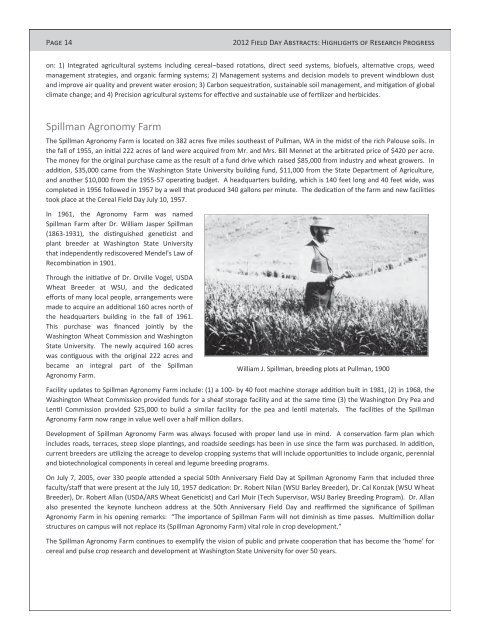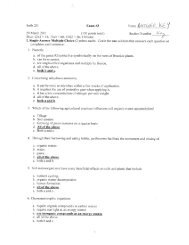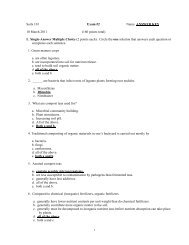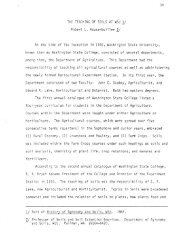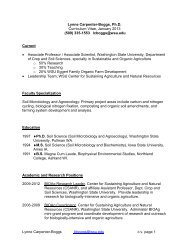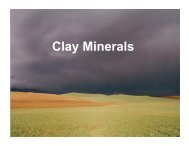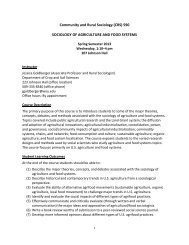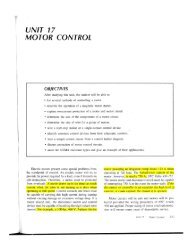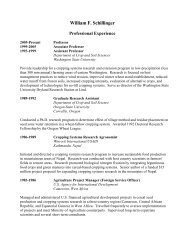2012 Dryland Field Day Abstracts - Dept. of Crop and Soil Sciences ...
2012 Dryland Field Day Abstracts - Dept. of Crop and Soil Sciences ...
2012 Dryland Field Day Abstracts - Dept. of Crop and Soil Sciences ...
Create successful ePaper yourself
Turn your PDF publications into a flip-book with our unique Google optimized e-Paper software.
Page 14<br />
<strong>2012</strong> <strong>Field</strong> <strong>Day</strong> <strong>Abstracts</strong>: Highlights <strong>of</strong> Research Progress<br />
on: 1) Integrated agricultural systems including cereal–based rotations, direct seed systems, bi<strong>of</strong>uels, alternative crops, weed<br />
management strategies, <strong>and</strong> organic farming systems; 2) Management systems <strong>and</strong> decision models to prevent windblown dust<br />
<strong>and</strong> improve air quality <strong>and</strong> prevent water erosion; 3) Carbon sequestration, sustainable soil management, <strong>and</strong> mitigation <strong>of</strong> global<br />
climate change; <strong>and</strong> 4) Precision agricultural systems for effective <strong>and</strong> sustainable use <strong>of</strong> fertilizer <strong>and</strong> herbicides.<br />
Spillman Agronomy Farm<br />
The Spillman Agronomy Farm is located on 382 acres five miles southeast <strong>of</strong> Pullman, WA in the midst <strong>of</strong> the rich Palouse soils. In<br />
the fall <strong>of</strong> 1955, an initial 222 acres <strong>of</strong> l<strong>and</strong> were acquired from Mr. <strong>and</strong> Mrs. Bill Mennet at the arbitrated price <strong>of</strong> $420 per acre.<br />
The money for the original purchase came as the result <strong>of</strong> a fund drive which raised $85,000 from industry <strong>and</strong> wheat growers. In<br />
addition, $35,000 came from the Washington State University building fund, $11,000 from the State Department <strong>of</strong> Agriculture,<br />
<strong>and</strong> another $10,000 from the 1955-57 operating budget. A headquarters building, which is 140 feet long <strong>and</strong> 40 feet wide, was<br />
completed in 1956 followed in 1957 by a well that produced 340 gallons per minute. The dedication <strong>of</strong> the farm <strong>and</strong> new facilities<br />
took place at the Cereal <strong>Field</strong> <strong>Day</strong> July 10, 1957.<br />
In 1961, the Agronomy Farm was named<br />
Spillman Farm after Dr. William Jasper Spillman<br />
(1863-1931), the distinguished geneticist <strong>and</strong><br />
plant breeder at Washington State University<br />
that independently rediscovered Mendel's Law <strong>of</strong><br />
Recombination in 1901.<br />
Through the initiative <strong>of</strong> Dr. Orville Vogel, USDA<br />
Wheat Breeder at WSU, <strong>and</strong> the dedicated<br />
efforts <strong>of</strong> many local people, arrangements were<br />
made to acquire an additional 160 acres north <strong>of</strong><br />
the headquarters building in the fall <strong>of</strong> 1961.<br />
This purchase was financed jointly by the<br />
Washington Wheat Commission <strong>and</strong> Washington<br />
State University. The newly acquired 160 acres<br />
was contiguous with the original 222 acres <strong>and</strong><br />
became an integral part <strong>of</strong> the Spillman<br />
Agronomy Farm.<br />
William J. Spillman, breeding plots at Pullman, 1900<br />
Facility updates to Spillman Agronomy Farm include: (1) a 100- by 40 foot machine storage addition built in 1981, (2) in 1968, the<br />
Washington Wheat Commission provided funds for a sheaf storage facility <strong>and</strong> at the same time (3) the Washington Dry Pea <strong>and</strong><br />
Lentil Commission provided $25,000 to build a similar facility for the pea <strong>and</strong> lentil materials. The facilities <strong>of</strong> the Spillman<br />
Agronomy Farm now range in value well over a half million dollars.<br />
Development <strong>of</strong> Spillman Agronomy Farm was always focused with proper l<strong>and</strong> use in mind. A conservation farm plan which<br />
includes roads, terraces, steep slope plantings, <strong>and</strong> roadside seedings has been in use since the farm was purchased. In addition,<br />
current breeders are utilizing the acreage to develop cropping systems that will include opportunities to include organic, perennial<br />
<strong>and</strong> biotechnological components in cereal <strong>and</strong> legume breeding programs.<br />
On July 7, 2005, over 330 people attended a special 50th Anniversary <strong>Field</strong> <strong>Day</strong> at Spillman Agronomy Farm that included three<br />
faculty/staff that were present at the July 10, 1957 dedication: Dr. Robert Nilan (WSU Barley Breeder), Dr. Cal Konzak (WSU Wheat<br />
Breeder), Dr. Robert Allan (USDA/ARS Wheat Geneticist) <strong>and</strong> Carl Muir (Tech Supervisor, WSU Barley Breeding Program). Dr. Allan<br />
also presented the keynote luncheon address at the 50th Anniversary <strong>Field</strong> <strong>Day</strong> <strong>and</strong> reaffirmed the significance <strong>of</strong> Spillman<br />
Agronomy Farm in his opening remarks: “The importance <strong>of</strong> Spillman Farm will not diminish as time passes. Multimillion dollar<br />
structures on campus will not replace its (Spillman Agronomy Farm) vital role in crop development.”<br />
The Spillman Agronomy Farm continues to exemplify the vision <strong>of</strong> public <strong>and</strong> private cooperation that has become the ‘home’ for<br />
cereal <strong>and</strong> pulse crop research <strong>and</strong> development at Washington State University for over 50 years.


